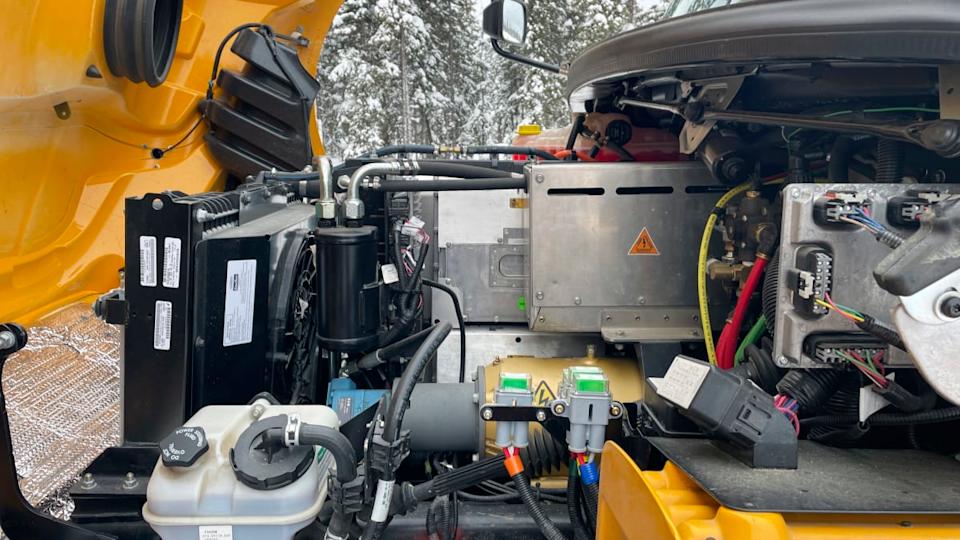The next big EV push is electrification of the iconic American school bus

The American school bus of the future won’t differ too much from its current iconic design: The wheels will still go round and round, the horn will go honk, honk, honk, and the wipers will swish, swish, swish. But if the transition from fossil fuels continues to accelerate, the engine won’t go vroom, vroom, vroom. It won’t make much noise at all, because it will be electric.
Most school buses today run on diesel. The climate footprint of a diesel school bus is about 3.3 pounds of carbon dioxide equivalent (CO2e) per mile, more than double the per-mile footprint (roughly 1.5 pounds of CO2e) for a bus powered on the average U.S. electric grid, according to Argonne National Laboratory. If a large share of the American school bus fleet — the largest mass transportation system in the country — electrifies, that would translate to a significant emissions cut.
What’s more, diesel exhaust is carcinogenic. And specific components of the tailpipe fumes, such as particulate matter and nitrogen oxides (NOx), are linked to asthma and other respiratory problems in children.
“This is really a health issue,” says Almeta Cooper, national manager for health equity with the environmental group Moms Clean Air Force. But with almost a half-million school buses on the road daily, “it’s so much part of the scenery, people don’t even realize,” she says. That’s why Cooper and other parent activists have spent recent years rallying behind the electric bus. Now, she says, the technology is finally starting to gain traction.
In 2016 there were only 10 electric school buses “committed” — meaning they’d been awarded, ordered or delivered, or were in operation — across the U.S., according to the global research nonprofit World Resources Institute (WRI). By December 2022, that number had jumped to 5,612. (That tally doesn’t include a partnership between bus dealer Midwest Transit Equipment Inc. and electric power system maker SEA Electric LLC to retrofit 10,000 diesel buses into electric; so far, only 22 of these buses have been ordered.) Those numbers account for the Environmental Protection Agency awarding more than $900 million in funding for nondiesel vehicles, mainly electric ones, through its new Clean School Bus Program. Even more federal support for school bus electrification is coming online this year, thanks to the 2021 Bipartisan Infrastructure Law and the 2022 Inflation Reduction Act.

Why school buses are going electric
It helps that school buses are almost perfect for electrification. The summer break means buses are generally not pulling power from the grid during the hottest months of the year, when electricity demand can peak. In fact, bus batteries could potentially be a resource to send electricity back to the grid.
The range of a fully charged electric bus is upwards of 100 miles, covering most routes. There’s also a natural window to charge during the day while kids are in class.
Take, for example, Montgomery County Public Schools (MCPS), a large suburban district in Maryland that currently operates 86 electric buses. On a typical day, an electric bus picks up students and drops them off at one high school, one middle school and two elementary schools from 7 a.m. to 9:30 a.m.
Occasionally, the buses take trips during the school day to nearby destinations. Although longer field trips pose a problem for range, a hypothetical 13-mile round trip to the Smithsonian National Zoo in Washington shouldn’t drain the battery. But if a bus needs to recharge during the day, it usually only recharges up to whatever it needs to finish the day’s routes.
“What you’ve got at the moment is many, many districts and users are putting their toes in the water,” says Kevin Bangston, CEO of Thomas Built Buses.
Not so for Montgomery County Public Schools, which plans to operate another 240 electric buses by the end of 2024 on top of the 86 already on the road. “We’re the sixth-largest school bus fleet in the U.S.,” says Gregory Salois, director of district transportation. “If you are able to do this successfully, it would be quite the advertisement for others to do it.”
Then, from 2 p.m. to 4:30 p.m. the bus picks up students from the schools and drops them off at home. Typically, morning and afternoon routes can be completed on a single charge. In colder months, the bus has less mileage per charge because heating the bus saps energy. Consistent high-speed driving can also deplete a battery more quickly.
At the end of the day, the bus returns to the bus depot to fully recharge overnight. Recharging to 100% takes about four hours, depending on how much charge is left.

 Yahoo Autos
Yahoo Autos 
